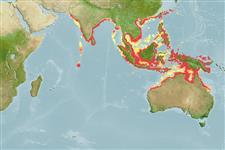Common names from other countries
>
Clupeiformes (Herrings) >
Dorosomatidae (Gizzard shads and sardinellas)
Etymology: Escualosa: Latin, squaleus, squalidus = with rough skin + Latin, alausa = a fish cited by Ausonius and Latin, halec = pickle, dealing with the Greek word hals = salt; it is also the old Saxon name for shad = "alli" ; 1591 (Ref. 45335).
More on author: Valenciennes.
Environment: milieu / climate zone / depth range / distribution range
Ecologia
marinhas; Água doce; estuarina; anfídromo (Ref. 51243); intervalo de profundidade 0 - 50 m (Ref. 188). Tropical; 27°N - 22°S, 64°E - 151°E (Ref. 188)
Indo-West Pacific: northern Indian Ocean (Karachi eastward to Rangoon) to Thailand, Indonesia (Java Sea), the Philippines, Papua New Guinea, and Australia.
Comprimento de primeira maturação / Tamanho / Peso / Idade
Maturity: Lm ?, range 7 - ? cm
Max length : 10.0 cm SL macho/indeterminado; (Ref. 188); common length : 8.0 cm SL macho/indeterminado; (Ref. 188); idade máx. registrada: 1.00 anos (Ref. 43081)
Espinhos dorsais (total) : 0; Raios dorsais (total) : 13 - 21; Espinhos anais: 0; Raios anais : 14 - 19. Belly strongly keeled. The almost rectangular second supra-maxilla and the bright silver stripe along the flank distinguish it from juveniles of Sardinella, Amblygaster and Herklotsichthys. Resembles some pellonulines with a silver stripe, but they lack a first supra-maxilla. Distinguished from E. elongata of the Gulf of Thailand but its deeper body and broader silver stripe.
Forms schools in shallow waters, the juveniles apparently entering the lower parts of rivers, but returning later to the sea. Feeds on both zooplankton (copepods, crab zoea, larvae of bivalves and fish eggs) and phytoplankton. Breeds from October to February (mainly November to January) off western coast of India, usually in relatively shallow inshore waters. Marketed fresh and dried-salted.
Whitehead, P.J.P., 1985. FAO Species Catalogue. Vol. 7. Clupeoid fishes of the world (suborder Clupeoidei). An annotated and illustrated catalogue of the herrings, sardines, pilchards, sprats, shads, anchovies and wolf-herrings. FAO Fish. Synop. 125(7/1):1-303. Rome: FAO. (Ref. 188)
Status na Lista Vermelha da UICN (Ref. 130435)
CITES (Ref. 128078)
Not Evaluated
Ameaça para os humanos
Harmless
Uso pelos humanos
Pescarias: espécies comerciais
Ferramentas
Relatórios especiais
Baixar XML
Fontes da internet
Estimates based on models
Preferred temperature (Ref.
115969): 26.7 - 29.1, mean 28.4 (based on 1160 cells).
Índice de diversidade filogenética (Ref.
82804): PD
50 = 0.7500 [Uniqueness, from 0.5 = low to 2.0 = high].
Bayesian length-weight: a=0.00776 (0.00514 - 0.01173), b=3.05 (2.93 - 3.17), in cm Total Length, based on LWR estimates for this species & (Sub)family-body (Ref.
93245).
Nível Trófico (Ref.
69278): 3.2 ±0.1 se; based on diet studies.
Resiliência (Ref.
120179): Elevada, tempo mínimo de duplicação da população menor que 15 meses (K=1.82; Fec=7,720; tmax=1).
Fishing Vulnerability (Ref.
59153): Low vulnerability (10 of 100).
